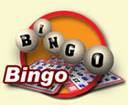Bingo
Cards, Games and History at BingoCards.com.
Understand
the background and variations of bingo cards and bingo tickets
used in the UK, Australia, United States and Canada.
Understand the basics of the bingo game. Learn
the differences between the two major bingo game
variations.
Read about bingo
history and the interesting story of its origins.
Understand the connection between bingo games and lottery games. |
|
| |
Why We Need Bingo Cards: A Very Brief Summary
of The Game of Bingo
Bingo is a game of chance, where players hope to
match numbers that are randomly drawn - and called
out by a neutral party - to those they possess on a pre-printed
bingo card.
In a multi-player game the first person to say “BINGO” wins!
|
|
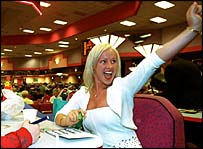
One should be dressed stylishly while shouting "BINGO!" |
|
| |
|
|
|
|
| |
Bingo Card Variations
For something so simple as a grid of numbers,
it is amazing that there are variations in bingo cards at all.
Perhaps not so amazing or unexpected, the North Americans and
British are separated by a common game. The New Worlders use
grids of 5 by 5 and play with 75 numbers, while the Brits and
Australians have historically used 9 columns and only 3 rows
with 90 numbers. You say tomato, I say potato. |
|
 
UK and Australia:
90 Balls Are Top Of The House
 
US and Canada:
Thrive and Thrive With 75 |
|
| |
|
|
| |
| |
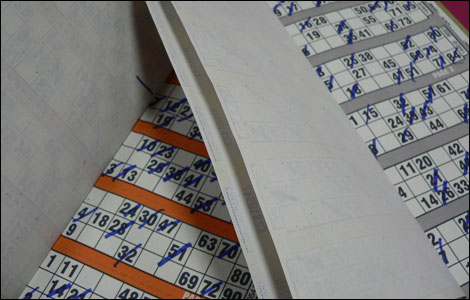
Well-Used Ticket Book

Single Ticket
|
|
Bingo Cards In The UK and Australia:
Just The Ticket
The traditional
bingo cards used in the UK and Australia come as a group of
6 or 10 “tickets” in
a book. Each bingo ticket contains a grid of 9 columns and
3 rows containing
15 numbers,
five per row, with the remainder of the 27 spaces blank.
These cards are used in a 90 number bingo game, where the numbers
1 through 90 are used to populate the cards.
On each
bingo card, numbers are placed in columns
by group. The first column will contain the numbers
1 through 9, the second 10-19,
the third 20-29, and so on. The ninth column contains the
80’s
series plus the number 90. Any number may appear only once on
any given bingo card. In the six card book, the numbers one through
ninety are used once each in the book, randomly scattered among
the
six cards.
In the ten ticket book, each bingo ticket might be colored
differently,
using Gold, Lime, Violet, Yellow, Pink, Grey, Orange, Blue,
Red and White.A “multiple book” will have six books. Each
page has 6 tear-apart bingo cards of the same color. A single
page of 6 cards
might be called a “flyer.”
|
|
| |
| |
|
|
| |
The 90-Number Bingo Game And Bingo
Cards
In this bingo game, the pool of numbers used are those
from 1 to 90. They are drawn and called or displayed by a neutral,
non-player or
computer one after another until a winner is declared.
The
objective of the player is to quickly determine if his
or her bingo card contains the called number and mark it in some
way to indicate the match, to get matches such that they form
a pre-determined pattern on the card, and be the first person
to declare “bingo.” In
the “live” version of the game with printed bingo
cards or tickets, a pen or marker might be used to cross-out
each
number as it is matched.
One bingo ticket or multiple tickets may be played
at the same time. Numbers are normally drawn and called quickly,
so the number of bingo tickets one can review before the
next number is called is naturally
limited. Playing the maximum number of tickets that can be
used effectively during a game increases the odds of winning
for that player.
The patterns used in the 90-number bingo game are invariably
One Line Across, meaning the first row of numbers is crossed-out,
Two
Lines
Across, meaning the first two rows are matched, and Full
House,
indicating that all the numbers on the bingo ticket are
matched.
Traditionally, in a bingo game there is a list of rhyming
slang or nicknames given to
each of the ninety numbers. These are seldom or never used
in cash or serious bingo games, because they might cause confusion
with some of the players, not to mention take too long to say. |
|
Bingo Calls For Bingo Cards: Rhyming Slang and Nicknames
1. Kelly's eye
2. Little boy blue
3. Cup of tea
4. Knock at the door
5. Man alive
6. Chopsticks
7. Lucky seven
8. Garden gate
9. Doctor's orders
10. Cock and hen
11. Legs eleven
12. One dozen
13. Unlucky for some
14. Valentines day
15. Young and keen
16. Sweet sixteen
17. Dancing queen
18. Key of the door
19. Goodbye teens
20. One score
21. Key of the door
22. Two little ducks
23. A duck and a Flea
24. Did you score?
25. Duck and dive
26. Pick and mix
27. Gateway to heaven
28. Over weight
29. You're doing fine
30. Flirty thirty
31. Get up and run
32. Buckle my Shoe
33. Dirty knees
34. Ask for more
35. Jump and jive
36. Three dozen
37. A flea in heaven
38. Christmas cake
39. Those famous steps
40. Life begins at
41. Time for fun
42. Winnie the Poo
43. Down on your knees
44. Open two doors
45. Halfway there
|
46. Up to tricks
47. Four and seven
48. Four dozen
49. Rise and shine
50. Bulls eye
51. I love my mum
52. Weeks in a year
53. Stuck in the tree
54. Clean the floor
55. All the fives
56. Was she worth it?
57. Heinz varieties
58. Make them wait
59. Brighton line
60. Blind 60
61. Bakers bun
62. Tickety boo
63. Tickle me
64. The Beatles number
65. Old age pension
66. Clickety click
67. Made in heaven
68. Saving grace
69. Any way up
70. Three score and ten
71. Bang on the drum
72. A crutch and a duck
73. Crutch with a flea, Queen B
74. Candy store
75. Strive and strive
76. Seven 'n' six - was she worth it?
77. All the sevens
78. Heavens gate
79. One more time
80. There you go matey
81. Stop and run
82. Fat lady with a duck
83. Fat lady with a flea
84. Seven dozen
85. Staying alive
86. Between the sticks
87. Fat lady with a crutch
88. Two fat ladies
89. All but one
90. Top of the house |
|
| |
|
|
| |
| |
|
|
Bingo Cards In The
U.S. and Canada: Land of the Free Space
In the United States and Canada, the standard bingo
card is a 5 by 5 grid, and 75 numbers are used in the game. A number
is not placed
in the middle square of the bingo card, that square counting as
filled or covered, and is usually marked “Free” or “Free
Space.” Twenty
four of the 75 numbers are therefore used on each bingo card.
Each column on the bingo card is labeled with a letter from
the word “Bingo,
with the first column labeled “B,” the second “I,” the
third “N,” the fourth “G” and the last “O.” The
numbers 1 through 15 are randomly assigned to the first, or B column,
16 through 30 the I column, 31 through 45 the N column, 46 through
60 the G column and 61 through 75 the O column. No number may appear
more than once per bingo card.
|
|
| |
| |
|
|
| |
The 75-Number Bingo Game And Bingo
Cards
The numbers 1 to 75 are used in the North American version of the
game. They are drawn and called or displayed by a neutral, non-player
or computer one after another until a winner is declared.
The objective of the player is to quickly determine if his or
her bingo card contains the called number and mark it in some
way to indicate the match, to get matches such that they form
a pre-determined
pattern on the card, and be the first person to declare “bingo.”
When printed bingo cards are used, a thick marker might be used
to daub each number with ink as it is matched, or beans or other
tokens might be used to cover the number. One card or multiple
bingo cards may be played at the same time.
Numbers are drawn and called in a measured and continuous way,
so the number of bingo cards one can review before the next number
is called is naturally limited. Playing the maximum number of
bingo cards that can be used effectively during a game increases
the odds of winning for that player.
The numbers in this bingo game are called along with the corresponding
letter, indicating the column in which the number will appear
on the bingo card. Examples include “B-4,” “I-20,” “N-44,” “G-52” and
O-75.”
The patterns used in the 75-number bingo game are many and varied.
The simplest is one row across, one number for each letter, thus
B-I-N-G-O is obtained and is enthusiastically exclaimed when
such a feat is accomplished. Popular patterns include: the “X” formed
by diagonals crossing in the middle square; “Picture Frame” formed
by all the numbers in the first and last rows, and first and
last columns, being successfully filled; “Plus” formed
by the middle column and middle row..
Patterns of number and letter shapes are also commonly used
in a bingo game, along with patterns with such intriguing names
as “Bow
Tie” and “Solid Diamond.” Matching all numbers
on a bingo card is known as “Coverall” or “Blackout.”
|
|
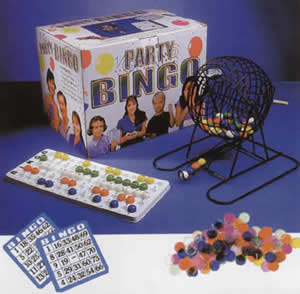
How to Turn the Home into a Bingo Hall.
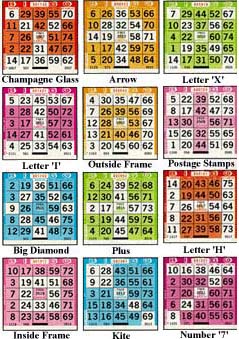
Sample Bingo Card Patterns for Winning
|
|
| |
|
|
| |
| |
Bingo Cards and Unusual Teaching
Subjects
Demographic Bingo Cards: “This
game allows the students to learn the breadth of demographic
aging trends.” [This is for a Gerontology class. It’s
fun but it gets old after awhile.]
Embryo Bingo Cards: “As soon as the players have five
characteristics of embryonic development marked they must yell EMBRYO!” [Kind
of inspires one to write a song about a dog doesn’t it: ‘…and
Embryo was his name-o?”]
Codon Bingo Cards: “As the names of DNA triplets are
called, they transcribe the DNA into an mRNA codon and then into its respective
amino
acid. If the codon
for an amino acid they have on their bingo card is called, they place a marker
on
the
appropriate spot.” [Right. Now I feel rather stupid.]
Body Bingo Cards: “For foreign language students to
learn body part words in English.” [Thousands of former students still
refer to the naval as “free
space.”]
Rap Bingo Cards: “Players use a six by six card and
substitute the word ‘Blingo’ for ‘Bingo.’ [I
made this one up.]
Election Bingo Cards: “Students will review election
vocabulary.” [Key
words on the card include “Mudslinging,” “Spin,” and “Soft
Money.” I’m not making this up.]
|
|
Educational Bingo: How We Can All
Learn from Bingo Cards
Bingo cards are very popular with teachers, who are
always searching for a way to “make learning fun.” They
are used by schoolteachers and leaders of adult seminars alike.
The general idea is for game participants to recognize on their
bingo cards the answers to questions raised by the moderator. For
example, the questions might concern outer space, and so the moderator
would
read “What do we call a pattern of stars in the sky?” Those
students with the word “Constellation,” or perhaps
a picture of a constellation, printed in one space on their bingo
cards would cover or mark that space. In order to “win” the
game, the student would not only have to complete the stated pattern,
but would also have to get all the answers correct!
A sample list of common subjects for which teachers have used bingo
cards and the bingo game include: Letters, Numerals, Vocabulary,
Spelling, Geography, Foreign Languages, Mathematics and Identification
of Objects (animals, plants, countries, etcetera). For small
children, bingo cards containing fewer numbers than the standard
15 or 24 may be used, a grid of 3 by 3 being common.
|
|
| |
|
|
|
|
| |
|
|
|
|
 |
 |
 |
 |
|
|
|
